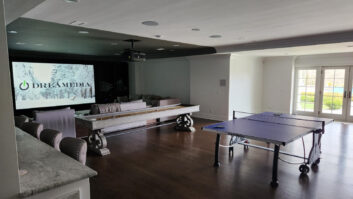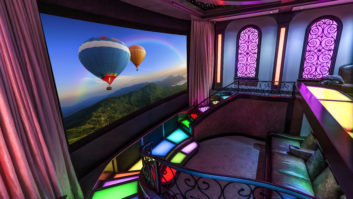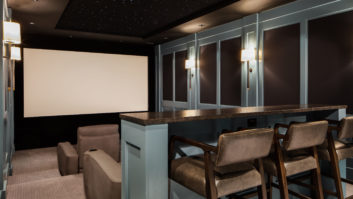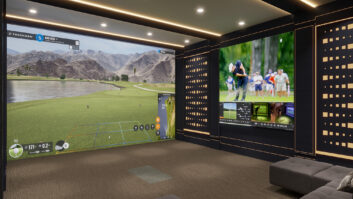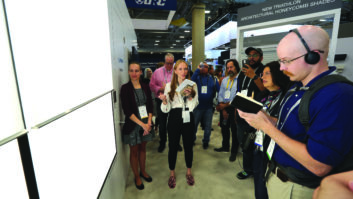On a surface level, what consumers want from projectors and screens seems to be obvious — to have that big theater feeling in their own homes. However, in speaking with several projector and screen experts, they also are expecting more these days. More resolution, more features, more…portability?
“Consumers now want to watch their favorite shows and movies anywhere they go, but also want reliable options to re-create the movie-going experience in the comfort of their own homes,” says Brian Soto, head of product management, Optoma Technology. “With the rise in popularity of compact, portable projectors, consumers are increasingly coming to expect the same performance quality and features in these modular options as they enjoy in the static projectors they have installed in their home theaters.”
For example, Optoma recently announced the Optoma UHL55, which packs 4K UHD quality and Amazon Alexa and Google Home compatibility in a small form factor, allowing users to project 4K quality content wherever they go. “In addition,” Soto adds, “we’ve introduced a 1300-lumen, 1080p LED option, the Optoma LH150, which comes with a built-in battery for maximum mobility and premium projection on the road. With these capabilities, consumers can get the same powerful performance and image quality as larger projectors produce, but in a completely compact and mobile size.”

In screens, the most common topic of discussion is ALR (ambient light rejection), says David Rodgers, marketing manager, Elite Screens. “EPV Screens (Elite Screens’ dedicated CI sales division) has not only developed a line of ALR projection screens, but has also developed a variant that is compatible exclusively with UST (ultra-short-throw) projectors, the DarkStar UST eFinity.”
More Integration Guides: Business Software
This touches on two more commonly discussed topics, UST and AT (acoustic transparency). “UST physically brings the projector and screen together so that there is no threat of foot traffic shadowing the image by passing between the projector and screen,” he explains. “The acoustically transparent quality of various materials is another topic for dedicated media rooms. In-wall speakers are still a staple for dedicated home theater design. While there are some combinations of AT and ALR (e.g., perforated ALR materials), the game still seems to be an either-or affair. Videophiles prefer the enhanced color contrast, black/white dynamic range, and overall picture performance. They tend to like their speakers unrestrained. For them, it’s entirely forgivable to have a center-line speaker below the image; and why not?”
It’s likely, Rodgers says, that the left-right and surround sound placement is visible as well. “Still, there is a high value on the aesthetics of combining the screens visual image with the center sound so that sound and image share the same point of origin. This is how the big theaters do it, so why not do it in the comfort of a home theater? Even though an AT material is essentially just a white material, as long as there is adequate light control in the room, an ISF-certified installer can calibrate the projector for an unbelievably good performance.”
The growing trend in residential AV is for large projection displays to move out of the dark room and into the living room, taking over the role traditionally held by flat panel TV sets, he notes. “The DarkStar UST eFinity delivers a larger-than-life image that can dwarf large household TV at a fraction of the cost. Likewise, large +100-inch flat panel TVs may require a structural engineer to determine if the wall can even bear the weight. The DarkStar UST eFinity negates all these drawbacks by providing a safer, easier, better installation without compromising on the quality of picture performance and is engineered to be used with UST ultra-short throw projectors.”
The innovative material utilizes a multiple-layered optical microstructure to filter out ambient light and up to 95-percent of overhead lighting, Rodgers says. “The design greatly enhances color contrast and dynamic range while maintaining a 180-degree viewing angle. This means that the 0.5 gain material enhances sharp, clear picture quality with superb image brightness. The design features EPV’s trademarked Edge Free internal framework with wrap-around material that also includes a sleek, 9mm bezel and variable color and mode LED backlighting kit.”

It’s Evolutionary
The latest on projectors is mainly the completion of the evolution of products to achieve compatibility with the current/latest video/HDMI standards, notes André Floyd, product marketing manager, projectors, Sony Electronics Inc.
“In terms of Sony’s world, thinking back about a year, we had a product line where, besides our two HD models, all of our 4K models had true 4K resolution, meaning over 8 million pixels on each of three channels (red, green, blue), providing over 24 million total pixels on the screen at any given instant. They also had HDR compatibility — both HDR10 and HLG (Hybrid Log-Gamma) — and HDR contrast adjustment, allowing users to adjust the luminance of mid-tones so as to make HDR content appear closer to SDR versions in terms of brightness without raising black levels, and wide color gamut (beyond BT.709).”
Sony also had two laser light source models that added features such as Infinite Dynamic Contrast that had the ability to modulate the laser, including completely off, if sent a true black signal; Motionflow motion compensation options for 4K content; full 18 Gbps HDMI inputs; and vertical stretch capability for 4K content, allowing use of anamorphic lenses with 4K content.
More Integration Guides: Automation Solutions
“We have expanded the processing power of the laser models down through our entry-level model so that they all have full 18 Gbps inputs, 4K Motionflow, 4K V-stretch, and 4K Input lag reduction for gaming,” Floyd says. “What you will find across the industry is that other manufacturers offer some combination of the above features, and promote the feature(s) that they have. But, what is the point of having 18 Gbps inputs if you are only capable of displaying two million (HD) or four million (single chip DLP) pixels on the screen at a time, for instance.”
A meaningful trend in home projectors is the use of laser light sources, he adds. “Sony added a third laser model to our line at CEDIA; JVC added a second model to their line, which is also a full 4K model. At the lower end, some of the single-chip DLP models are using laser light sources, often mirroring their manufacturers’ B2B models.”
With the use of laser light sources, a very new feature is the Dual Contrast Control, which means that a projector (like Sony’s just-introduced VW995) employs both a physical iris (in Sony’s case, a dynamic iris) as well as modulating the laser. “This allows the darkest areas of a dark image (e.g., night time) to be inky-black, while highlights such as headlights or street lights appear as bright as one would expect in real life,” he notes. “The underlying concept/promise of HDR is to provide images on the screen to appear closer to the way they would in real life without being artificially limited to fit within the capabilities of displays no longer in use.”
In thinking about 4K, one is inherently thinking about resolution, Floyd explains. “Once you have a set of imagers that can create full color, full resolution 4K, maintaining that detail all the way onto the screen becomes extra important. What we’ve done in this regard started with our first 4K projector (VPL-VW1000ES) by creating a new All Range Crisp Focus (ARC-F) lens, designed specifically to transmit the detail of the 4K image to the screen, from corner to corner. When we introduced the VW5000, we used that lens. Now, the new VW995 includes that lens, as well. We’ve also added a new feature called the Digital Focus Optimizer. Briefly, this feature takes into account the fact that lenses become less sharp as you move from the center to the edge of the lens, and digitally pre-corrects for the sharpness reduction based on the portion of the lens being used at the time.”
Like this Integration Guide? Want to read others? We have plenty — click here to see them all!
